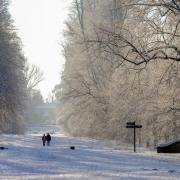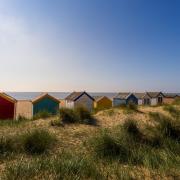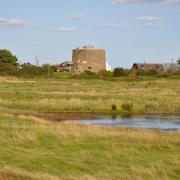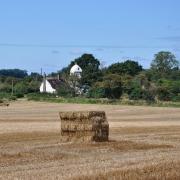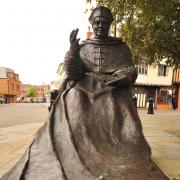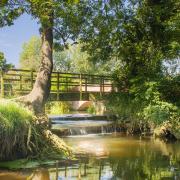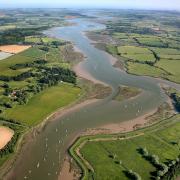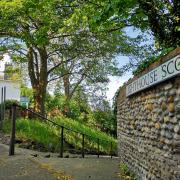Lindsay Want takes a north Suffolk stroll which reveals the unusual split personality of Rickinghall and leads not just up hill, but down Botesdale too.

Fancy a spot of hill- walking? Well, that’s pretty steep coming from Suffolk, a county of flatlands, fenny meadows, wide open heathlands and outstretched shingle spits. But it’s not such an outrageous suggestion. Our county certainly has the inclination – you just need to know where to look for it.
Up in High Suffolk where our landscapes reach their loftiest heights on the Newmarket Ridge (a whopping 128m/ 420ft), a summer stroll around Dalham soon reveals a village with more than its fair share of ups -and¬-downs. The Upper Mill stands tall in its smock and beehive cap, yet the lower Opposition Mill is no more, and the views from lofty St Mary’s are quite breathtaking, especially after the climb from the thatched village idyll below.

Take a ramble round Upper and Lower Somerton, en route to Hartest and Boxted, and you’re certainly on one wonderfully scenic rollercoaster ride, although a walk through historic Woodbridge could probably clock up even more mills and hills. Or maybe step back in time down snaking pathways to Syleham’s round tower church on a sand lens of the Waveney near Wingfield. Here, the witch’s hat mill by the village’s upmost great common seems more than a world away.
From Ufford to Ousden and Layham to Laxfield, there are upper greens and low houses, high streets and lower meadows – perfect sets of purposeful peaks and time-honoured troughs, each highlighting their differences, yet gently living as one in the unfurling landscape. But there’s one set of Suffolk villages whose highs and lows are distinctly more pronounced than others.

Two of a kind
Rickinghall Inferior and Rickinghall Superior sound like some strange throw¬back to feudal times, a pair of right old characters, clearly at opposite ends of a Suffolk scale. They’re definitely divided now by the whizz of the A143, which whisks traffic between Diss and Bury, carefully bypassing the main street of historic houses that stretches seamlessly to become Botesdale, once part of the main coach road from Norwich to London.
The Latin names are just old ways to express the lie of the land around here, but the good local ladies of the WI treated the predicament with a healthy dose of tongue-in-cheek when they designed the two¬faced village sign. On the Rickinghall Inferior side, there’s a stern looking old mawther with golden plaits and an equally golden sheaf of corn tucked under her muscular arm, skirting along the river near the church. The Rickinghall Superior side depicts a gaunt, yet distinctly upright medieval gent, with clasped hands and a demeanour that’s wonderfully open to interpretation as sheer arrogance or pathetic whimpering!

Park up at the village hall, put your best foot forward and signs to St Botolphs Way also point to another red herring. Admittedly Botolph (a patron saint of sailors, but also agricultural workers and travellers) could theoretically have wandered these parts. He did set up a monastery on the Alde in the 7th century to consolidate Christianity in God¬forsaken East Anglia, and won quite a name for himself exorcising demons from Suffolk’s marshlands around Iken and Grundisburgh. When the busy west to east trade route was deemed worthy of a major fair in medieval times, an annual market was granted for June 17, St Botolph’s saint’s day.
Down at heart

Situated in a hollow by the brook and snuggling in a huge green nest of a churchyard, St Mary’s at Rickinghall Inferior is truly beautiful. No lofty tower here, just an elegant octagonal belfry – and a tall memorial amid the gravestones laced with heart¬rending tales of young lives lost in war and in the deep crevasses of Mont Blanc.
Onward to Low Meadows, linking two parishes at opposite ends of a spectrum. Beyond, a blossom tunnel of spindly blackthorn stops sharp alongside the sprawling water meadows to cross the A143 corridor. A leafy path later, Briar Lane takes a hold, before way¬markers point over a sleeper bridge and up, up between the fields where church tower number two sticks its head between the crenulations of a defensive tree¬line.
At the mixed woody patch of pines on the peak Summer Lane leads onwards and gently downwards, making a beeline for a sleepy thatched hamlet, where the church sits slightly aloof. Haughty, but nice.

At the end of Candle Lane, it’s a bit of a clamber up the steep grassy bank to St Mary’s (II), a gem of a church covered with vast swathes of the finest chequerboard patterns of flint. Its tower is tall, its windows massive and its views reach down across the steep thatch and pantile roofs below.
Rickinghall Superior this may be, a church which made the grand gesture of giving up its altar and furnishings for the Redgrave USAAF hospital in World War II, but the great place was declared redundant in 1977. It has since come up trumps as a concert and community venue, thanks to the continued generous spirit of the local community and the Churches Conservation Trust.

From Church Lane, paths lead up past the pump house to Potters Lane and Common Road, dog¬legging back, along leafy byways popular with four¬legged friends taking their masters for a walk. There’s a subway for safe passage under the A143, then path and pooches disappear down a hollow¬way, to surface by the old Bridewell, perhaps a former Correction House, tucked away in the back streets of Botesdale. A right hook along Chapel Lane and swing to the left at Mill Road, puts things back on the straight, yet not so narrow The Street at the brow of Botesdale Old Crown Hill.
Here the village sign boasts of mills and mail coaches, spade¬loads of root crops and a place to do business. And sitting fair and square, in pride of place is St Botolph, the man who gave his name to the great annual market granted by King Henry III back in 1227. Records recall that Thursday markets were held in the hamlet from 1220 through to the 18th century. By 1289 there were 52 stalls and 14 shops and as Lord of the Manor, the Abbot of Bury St Edmunds had cause to own a pair of windmills plus a pillory and ducking stool.
Kings, queens and a special sort of club
Cue St Botolphs – a little chapel for wayward souls, now with a very surprising Suffolk twist. It was built as a chapel of ease in the early 1300s, so popping in for prayers didn’t necessitate a trek all the way to Redgrave. By 1470 it had become a chantry chapel, with its priest paid to look after the souls of those in the special club. Travellers passing through for a prayer of safe passage to Norwich or London met Latin pleas above the door to help secure certain souls a swift journey through purgatory. Edward VI put a stop to it all in 1547 and by 1561 Elizabeth I’s Lord Keeper of the Seal, Sir Nicholas Bacon, had made it into a grammar school. Closed only in 1878, it was then divided into lots and sold off – part of it was restored as a chapel, the rest now blushes bright Suffolk pink as a private residence.
Step up your game
You’ll find details of two similar short walks (2.5 or 6 miles) around Botesdale and The Rickinghalls or the 10 mile St Botolphs Way downloadable for free at www.rickinghall.onesuffolk.net and www.botesdale.onesuffolk.net. All routes are circular with some way¬markers in place and walkers are welcome to park in designated spaces at Rickinghall Inferior village hall. Both St Marys (RI) and St Botolphs Chapel of Ease are open on Saturdays (until end September/October respectively) and there are local keyholder details for St Marys (RS) at the church.
For a real insight into the fascinating history of these parishes why not visit on Saturday July 9 for the Bringing Local History Alive event at Rickinghall Inferior Church (www.quatrefoil.org.uk).










